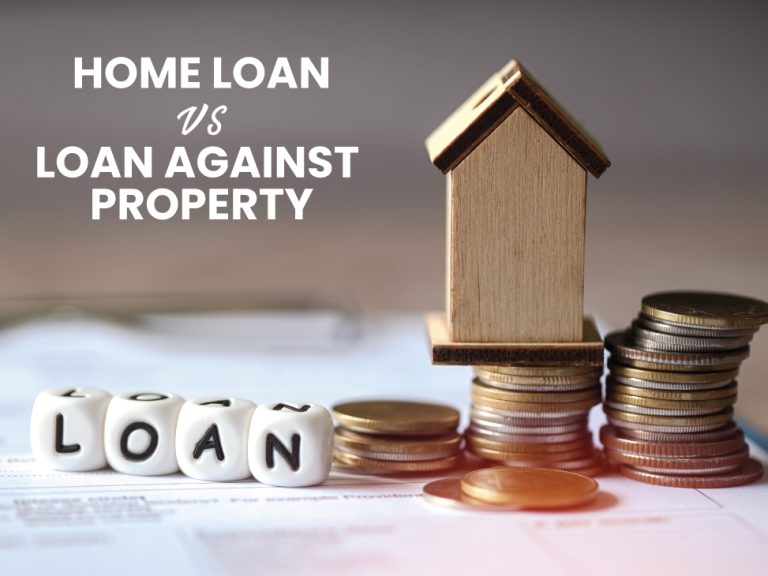Meenakshi Taheem
Last Updated on 20th May 2025

Meenakshi Taheem
Last Updated on 20th May 2025
When it comes to financing major expenditures like buying a house or funding a child’s education, many individuals find themselves comparing two popular loan options: Home Loan and Loan Against Property (LAP). While both these financial products are secured loans, they serve different purposes and have distinct features. In this blog, we will delve into the nuances of Home Loan and Loan Against Property, helping you make an informed decision based on your financial needs and circumstances.
Table of Contents
A Home Loan is specifically designed for purchasing a new home, constructing a house, or renovating an existing property. It is a secured loan where the property being purchased or constructed serves as collateral. Home Loans are popular because they offer a long repayment tenure, competitive interest rates, and tax benefits under various sections of the Income Tax Act.
Suggested read: Top Banks for Home Loans in India
LAP’s full form in banking is Loan Against Property. It involves borrowing a significant sum of money by mortgaging an owned property. The loan amount depends on the current market value of the property. LAP can be used for various purposes like financing a business, funding education, medical expenses, or any other personal needs. It does not restrict the end-use of the funds.
Suggested read: Business Loan vs Loan Against Property
| Feature | Home Loan | Loan Against Property (Mortgage Loan) |
| Purpose | To purchase a house, plot, or under-construction property | For business or personal use |
| Margin | Up to 90% of the property value | Up to 60% of property value |
| Tenure | Up to 30 years | Up to 15 years |
| Tax Exemption | Available under Section 24 (interest) & 80C (principal) | None |
| Interest Rate | Starts from 8.50% | Starts from 9.50% |
| Processing Fee | Up to 1% of the loan amount + applicable taxes | Up to 1% of loan amount + applicable taxes |
| Bank/NBFC | Home Loan Interest Rate | Loan Against Property Interest Rate |
| SBI | 8.50% onwards | 9.95% onwards |
| HDFC | 8.55% onwards | 9.90% onwards |
| AXIS | 9% onwards | 11.25% onwards |
| PNB Housing | 8.75% onwards | 10% onwards |
| LIC Housing Finance | 8.50% onwards | 10.50% onwards |
Choosing between a Home Loan and a Loan Against Property depends largely on the purpose of the loan and your financial situation. If you are looking to buy, construct, or renovate a home and can benefit from the tax deductions, a Home Loan is likely the better choice. On the other hand, if you need funds for diverse personal or business needs and have an existing property to mortgage, LAP could be more suitable.
Both Home Loans and Loans Against Property have their own set of benefits and limitations. It’s crucial to assess your financial goals, repayment capacity, and the purpose of the loan before making a decision. Understanding the nuances of each option can help you choose the one that aligns best with your financial strategy and long-term objectives. As with any financial decision, it.
Eligibility criteria typically include a stable income source, a good credit score, age (usually between 21 and 65 years), and the property’s legal and valuation status. For LAP, the property’s market value and condition are also assessed.
Home loan interest rates generally range from about 8.5% to 10.5%, while loan against property interest rates are slightly higher, usually between 9.5% to 12%, varying by lender and market conditions.
A home loan is specifically for buying, constructing, or renovating a residential property, with the property itself as collateral. LAP is a loan secured against any owned property for various personal or business purposes, not restricted to housing.
Home loans offer tax deductions on both the principal and interest under various sections (like Section 80C, and Section 24) of the Income Tax Act in India. LAP generally doesn’t offer tax benefits unless used for building or purchasing a property.
It can be challenging to get a loan against property without income proof as lenders assess repayment capacity based on income. However, some lenders may consider other factors like property value, credit history, or alternative income sources.
Generally, it’s not possible to directly convert a mortgage loan (LAP) into a home loan because they serve different purposes and have different terms. However, one can use a LAP to buy or construct a property and then refinance it with a home loan, subject to lender policies and eligibility.